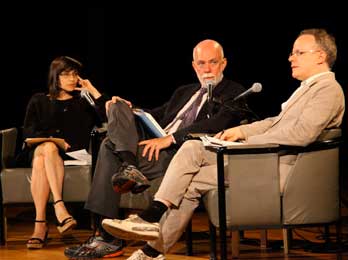
A WARM, HIGH-SUMMER EVENING IN THE CITY found a good proportion of New York’s first-tier museum directors and curators present at the Guggenheim to hear a conversation with peripatetic Swiss curator Hans Ulrich Obrist, currently codirector of the Serpentine Gallery in London. Lisa Phillips, Glenn Lowry, and Thelma Golden were among those paying this compliment to their visiting colleague. (One important local director, who arrived without a ticket, was turned away from the sold-out event.) They and the quietly attentive crowd were rewarded with a rapid-fire but softly spoken seminar by Obrist, who was prodded by succinct questions from the museum’s director, Richard Armstrong, and chief curator, Nancy Spector, on the forgotten history of curating as both intellectual discipline and experimental art form, indeed as the primary object of a modern art history yet to be written.
The ostensible occasion for Monday’s event was the “relaunch” of Obrist’s 2008 book, A Brief History of Curating, composed from interviews he had accumulated since the 1990s with curators whose examples he saw as formative for his own practice. The names ranged from those with the renown of Pontus Hultén and Anne d’Harnoncourt to those of more esoteric reputation, like Jean Leering and Franz Meyer, who directed public collections in Eindhoven and Krefeld respectively, as well as collaborating on an influential Documenta exhibition each. Behind such figures, Obrist was at pains to emphasize, lay other, equally important innovators, whose contributions are in danger of slipping from historical consciousness altogether. An example he cited more than once was the late James Speyer of the Art Institute of Chicago, whose training in another field (architecture with Mies van der Rohe) Obrist finds to be a common thread among the true pioneers.
Fortunately for those who missed many of those names in the course of Obrist’s swift allusions, these genealogies can be reviewed at leisure in his book. He was more than clear, however, in insisting that the history of modern art, as construed by the museum and the academy alike, has been narrowly and uncritically limited to a history of objects, when it might be more fully understood as a history of exhibitions. He pointed out that exhibitions are not collected nor have they been documented with the consistency and depth that historical research requires, leaving in obscurity the work and imagination of curators who absorbed the lore of their elders and informally passed on their accumulated expertise to the succeeding generation: Only by comprehending those genealogies can we understand how some objects rather than others entered into conventional art history. In his recent experience, Obrist went on to say, the improvised discipline of curating has been straining against its confinement to the art world, offering a model of communication and the articulation of knowledge that is increasingly attractive to scientists, architects, and novelists.
Six of Obrist’s eleven interview subjects died before the book saw the light of day, and that fact lent the low-key passion of Obrist’s remarks both an urgent and an elegiac character. The Guggenheim has a special institutional interest in memorializing one of the departed, Walter Hopps, who organized its Robert Rauschenberg and James Rosenquist retrospectives from his base as adviser to the Menil Collection in Houston. Obrist places his exchange with Hopps at the beginning of his sequence of interviews, which made for a nice alignment of priorities between author and institution that evening. In a charming touch, event co-organizers ForYourArt distributed to the audience reproductions of the badge reading WALTER HOPPS WILL BE HERE IN TWENTY MINUTES, which his staffs at the Pasadena Museum of Art, the Corcoran, and the Smithsonian once wore with a mixture of exasperation and pride.
The conversation had indeed been announced as an opportunity to hear all three participants reflect on Hopps’s legacy, though there were some listeners lingering at the reception afterward who felt that the designated man of the hour had never really arrived as a vivid presence in the discussion. Not that Obrist was stinting in his praise, particularly for Hopps’s ability to conceive an exhibition as a “self-organizing” entity, notably in the 1978 “Thirty-Six Hours” exhibition in Washington, where Hopps announced that he would hang any work brought to the venue (the Museum of Temporary Art) during the titular time frame of the show—an example Obrist said was kept securely in his own “toolbox” of ideas. It is also more than clear that Obrist shares with Hopps a fearless drive to take chances and confound categories, combined with a warmly inclusive generosity toward valid artmaking at all levels and in any medium.
For an audience that skewed toward the young, however, it might have been illuminating to spend a little more of the allotted time bringing out the essential style of Hopps as counterweight to the ever-present forces of institutional conformity. Some pictures might have helped: During the ’60s, when his peers embraced the counterculture, he always wore a suit and tie. Those who knew him best called him Chico, a link to his physician father’s expatriate years in Mexico. In his later years, as museum-executive style had veered toward aping the sartorial armor of Wall Street and corporate trustees, Hopps went casual with a broad-brimmed hat that brought out the charro evoked by his youthful nickname. The tall, angular presence; the even, never ruffled speech; the deep well of experience behind nearly every utterance: It would take Clint Eastwood in glasses to play him. Even a shadow of that Hopps would have been worth just about any wait. | 